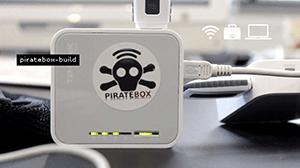Class 8 notes - Intro to Python and PirateBox
Class schedule
- intro to Python
- class project - PirateBox
Python
Python, what is it good for?
Python, first released in 1991, is a general purpose language emphasizing easy readability and logical structure and is meant to be fun to use.
Some advantages of Python:
- It’s a “high level language” meaning that it is further away from machine code with simplified layers of abstraction (variables, loops, arrays, objects, etc)
- It’s cross-platform. It works on Mac, PC, Linux, Servers - powerful super computers and tiny Raspberry Pi’s. Recently a version has been ported to control microcontrollers.
- There is a huge community of Python programmers. There are so many ways to learn it, and lots of answers available online.
- The Python ecosystem is vast. It can be used to simplify scripting for many other applications, hardware, and even works with lower-level languages like C and C++.
- The syntax is simple and beginner-friendly
- It is a general purpose language that can work for a variety of tasks: system processes, desktop applications, server software, machine learning, automation, and even mobile apps
Python’s philosophy
Beautiful is better than ugly. Explicit is better than implicit. Simple is better than complex. Complex is better than complicated. Readability counts. –from The Zen of Python
Java and C++ are object-oriented languages. Python is a multi-paradigm language. This means it has several different ways it is generally used, including object-oriented modes.
Tutorial
Let’s talk about:
- variables
- if statements
- loops
- lists
Python 2 vs 3
There are 2 main branches of Python. Annoying!
Over time, languages are refined and improved. Python 2 was released in 2000. Python 3 was a large revision of the language and released in 2008. So many ongoing programs were written in 2 that a decision was made to continue to improve Python 2 even while Python 3 was further developed. Python 2.7 will be sunset on January 1, 2020, meaning that the language will not be further developed, de-bugged or supported. When you find code online, check to see whether it is in Python 2 or Python 3.
Generally, most shell’s run Python 2 by default. To launch the Python 3 interpreter, type python3 if it’s installed.
Tutorial
Hello World!
print("hello world")
NOTE: In Python2, you can also just do print "hello world".
Indentation
Python uses indentation to specify blocks of code, instead of { }. The amount of indentation indicates your current scope level.
example:
if x == 1:
print "x is 1"
Variables
Python is a dynamic language. You do NOT need to declare the type of variable. You do not need to declare a variable before using it.
Types of Numbers
- Floats
- Integers
myInt = 7
myFloat = 7.0
Strings
myString = “some text”
Lists
Lists are similar to arrays in other languages. Python has a number of built in methods to work with lists. Lists may contain any mixture of strings and numbers and variables.
myList = [1, 2, "three"]
String methods
myList.append('another thing')
myList.insert(0,"zero")
del myList[4]
myList.pop() # removes last item
myList.pop(4) # removes 4th item
myList.remove('zero') #removes a value that matches
myList.sort() #sort
myList.sort(reverse=True) #sort in reverse
myList.reverse() #flip list around
len(myList) # the length of the list
You can loop through lists
for item in myList:
print(item)
for value in range(1,6):
print(value)
Lists of numbers
digits = [0, 1, 2, 3]
min(digits) #0
max(digits) #3
sum(digits) #6
print(digits[0:3]) # slicing
Copying a list
newList = digits[] #points to old list
digits.append(4)
print(newList) #0, 1, 2, 3, 4
#copying list just points to old list!
Tuple: a list that cannot be changed
tuple = (0, 1, 2)
tuple[0] = 23 # ERROR!
Dictionary
dictionaries are combinatons of key-value pairs.
alien = {'color':'green','age':5}
Functions
def hello(username):
print("hello "+username)
hello("Xavier")
def hi(username="Lee"):
print("hi "+username)
hi() # prints hi Lee, the default parameter
hi("Justine") #prints hi Justine
Modules
Modules are files with variables and functions and classes. You can import them into your program to use them.
There are a number of prebuilt modules, or you can download others’ modules.
import pizza #imports a file pizza.py
pizza.make_pizza('pepperoni')
# runs the make_pizza function, with a parameter, from pizza module
# OR
#
from pizza import make_piza
#imports just a single function instead of entire module
# OR create an alias for a function
from pizza import make_pizza as mp
mp('pepperoni')
from pizza import * #imports everything
Advanced python
- classes and objects
Resources / Tutorial
- official Learn Python
- python.org
PirateBox project

-
my nates on altering PirateBox on Pi
sudo nano /etc/minidlna.conf
- Change the filesharing directory
- change the presented url from piratebox.lan to something else
- add album artwork
LibraryBox
Homework:
- complete your piratebox
- customize it, make it yours. What is the concept? Who does it serve? Where is it deployed? What alterations are you making to it?
- what are you serving? build a nice landing page
The completed Piratebox project should have:
- Title
- Purpose/Concept
- List of parts
- Custom landing page/intro page
- Screenshots from you connecting to your piratebox from your own computer
- Complete documentation walk through of your building process. Write down every step you took. Make sure you write a description of what you worked on, every 20 minutes!